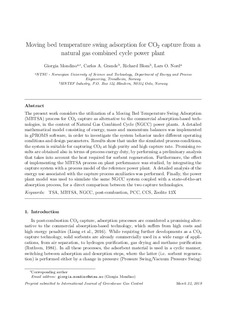| dc.contributor.author | Mondino, Giorgia | |
| dc.date.accessioned | 2019-06-06T06:37:18Z | |
| dc.date.available | 2019-06-06T06:37:18Z | |
| dc.date.created | 2019-06-05T11:21:09Z | |
| dc.date.issued | 2019 | |
| dc.identifier.citation | International Journal of Greenhouse Gas Control. 2019, 85 58-70. | nb_NO |
| dc.identifier.issn | 1750-5836 | |
| dc.identifier.uri | http://hdl.handle.net/11250/2600057 | |
| dc.description.abstract | The present work considers the utilization of a moving bed temperature swing adsorption (MBTSA) process for CO2 capture as alternative to the commercial absorption-based technologies, in the context of natural gas combined cycle (NGCC) power plants. A detailed mathematical model consisting of energy, mass and momentum balances was implemented in gPROMS software, in order to investigate the system behavior under different operating conditions and design parameters. Results show that under the simulated process conditions, the system is suitable for capturing CO2 at high purity and high capture rate. Promising results are obtained also in terms of process energy duty, by performing a preliminary analysis that takes into account the heat required for sorbent regeneration. Furthermore, the effect of implementing the MBTSA process on plant performance was studied, by integrating the capture system with a process model of the reference power plant. A detailed analysis of the energy use associated with the capture process auxiliaries was performed. Finally, the power plant model was used to simulate the same NGCC system coupled with a state-of-the-art absorption process, for a direct comparison between the two capture technologies. | nb_NO |
| dc.language.iso | eng | nb_NO |
| dc.publisher | Elsevier | nb_NO |
| dc.rights | Attribution-NonCommercial-NoDerivatives 4.0 Internasjonal | * |
| dc.rights.uri | http://creativecommons.org/licenses/by-nc-nd/4.0/deed.no | * |
| dc.title | Moving bed temperature swing adsorption for CO2 capture from a natural gas combined cycle power plant | nb_NO |
| dc.type | Journal article | nb_NO |
| dc.type | Peer reviewed | nb_NO |
| dc.description.version | acceptedVersion | nb_NO |
| dc.source.pagenumber | 58-70 | nb_NO |
| dc.source.volume | 85 | nb_NO |
| dc.source.journal | International Journal of Greenhouse Gas Control | nb_NO |
| dc.identifier.doi | https://doi.org/10.1016/j.ijggc.2019.03.021 | |
| dc.identifier.cristin | 1702894 | |
| dc.description.localcode | © 2019. This is the authors’ accepted and refereed manuscript to the article. Locked until 8 April 2021 due to copyright restrictions. This manuscript version is made available under the CC-BY-NC-ND 4.0 license http://creativecommons.org/licenses/by-nc-nd/4.0/ | nb_NO |
| cristin.unitcode | 194,64,25,0 | |
| cristin.unitname | Institutt for energi- og prosessteknikk | |
| cristin.ispublished | true | |
| cristin.fulltext | postprint | |
| cristin.qualitycode | 2 | |

